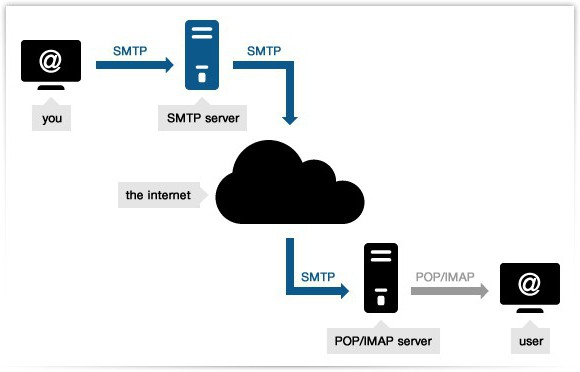Every user who works with mail applications, one way or another, is faced with setting the parameters of incoming and outgoing correspondence. One of the main elements is the configuration of the outgoing mail server – SMPT. Consider what it is and how to make the necessary adjustments for different situations.
SMTP (Simple Mail Transfer Protocol) is the standard protocol for sending email over the Internet. Its scope is limited to TCP / IP and user level networks.

In any email program, it is often referred to as an email client and there are special settings that allow you to configure protocol parameters. Therefore, all e-mails are sent to the outgoing email server, where they expect retransmission.
SMTP works in three ports:
- port 25 is the unencrypted SMTP port by default;
- port 2525 – open to all Site Ground servers if port 25 is filtered (for example, by your ISP) and you want to send unencrypted e-mail messages using SMTP;
- port 465 – used if you want to send messages securely using SMTP.
Outgoing Mail Server (SMTP)
This is a server that is used only for sending emails. Most outgoing mail servers use Simple Mail Transfer Protocol (SMTP) to send correspondence. Depending on your network settings, the outgoing server may belong to the Internet service provider or to the server where you set up your account. Alternatively, you can use a subscription-based SMTP server that allows you to send email from any account. Due to spam problems, most outgoing email servers do not allow you to send emails unless you are logged in. An open relay server will allow you to use it to send email, whether or not you belong to its network group.
Email Ports
For networks, port means the endpoint of a logical connection. The port number determines its type. The following are the default outgoing mail server ports:
POP3 – port 110;
IMAP – port 143;
SMTP – port 25;
HTTP port 80;
Secure SMTP (SSMTP) – port 465;
Secure IMAP (IMAP4-SSL) – Port 585;
IMAP4 over SSL (IMAPS) – port 993;
Secure POP3 (SSL-POP) – port 995.
Email protocols: SMTP protocol
Basically, the protocol refers to the standard method used at each end of a communication channel. To work with email, you must use a special client to access the mail server. On the other hand, they can exchange information using completely different protocols.

The purpose of the SMTP protocol is reliable and efficient transmission of e-mail messages regardless of the communication medium used for that purpose. SMTP only requires a reliable, edited data channel to transmit, which in most cases implies a TCP communication channel, although SMTP can also be used on other types of communication channels.
An important functionality of the SMTP protocol is its ability to transmit e-mail messages between two or more separate networks (SMTP mail relaying) where each network consists of servers available through TCP protocols and the Internet and from servers accessible via TCP / IP protocols that are separate from the Internet by firewalls and are part of a separate internal network. Also, the network may also consist of servers available through a protocol other than TCP / IP that are part of separate local or wireless networks. To transmit messages within a network or between networks, the power SMTP protocol uses indirect servers that are accessible by the networks involved in communication, thereby transmitting messages from the sender to the recipient, no matter how many different networks are between them.
The most common SMTP status codes and announcements
There are many reasons why email has not been delivered to the recipient’s
mailbox. If this happens, an error message is
automatically sent to the sender.
The message contains information
about the SMTP status code for this error, as well as an additional description.
According to the SMTP status code and message text, you can find
out why the email was not delivered.
The email address is not spelled correctly or does not exist
When the recipient’s address is invalid, the error message contains the
following text:
No Such
User Here, Invalid Recipient, Mailbox not found, Invalid mailbox, User unknown,
Mailbox unavailable.
550 5.1.1
Recipient address rejected: User unknown in virtual mailbox table.
554
delivery error: Sorry, your message to emailaddress@yahoo.com cannot be
delivered. This mailbox is disabled (554.30).
Carefully check that you have
entered the recipient’s email address. If necessary,
correct it and try sending the email again. If you
receive the same error message again, it is very likely that this email address
does not exist (anymore).
The recipient’s mailbox is full
When the recipient’s mailbox is full, the error message looks like this:
Mailbox Full, Mail quota exceeded, Not enough disk quota, Over quota, Mailbox size limit exceeded.
452-4.2.2 The email account that you tried to reach is over quota.
452 4.2.2 Mailbox is full / Blocks limit exceeded / Inode limit exceeded
552 5.2.2 Mailbox is full / Blocks limit exceeded / Inode limit exceeded
552 5.2.2 Quota exceeded (mailbox for user is full)
Usually a message for a packed mailbox has code 4.2.2 and in that case the email server will try to send the email after a certain period of time.
If a message with code 5.2.2 is received, the email server will not attempt to resend the email. You can then try sending the email yourself after a while, or search for another email address of the recipient.

The email is probably spam, the sender is blacklisted or the like
When the
email server recognizes the message as SPAM, a similar error message will
appear:
High
probability of spam, Rejected due to IP Reputation policy, Message not allowed,
The mail server detected your message as spam and has prevented delivery,
Command rejected, Service unavailable, Client host blocked using Customer Block
list, Rejecting due to security policy.
550 Anti
Spam Engine has blocked this Email because the sender IP Address is blacklisted.
554 Reject
due to policy restrictions.
550 5.7.1
Message rejected as spam by Content Filtering.
550 5.7.1
Unfortunately, messages from [IP Address] weren’t sent.
550 #
5.7.1 DMARC verification failed.
550 5.7.1
Service unavailable, MailFrom domain is listed in Spamhaus.
If you receive such an error
message, carefully examine the email to find items that can be recognized as
SPAM.